Dust Events over the Urmia Lake Basin, NW Iran, in 2009–2022 and Their Potential Sources
Abstract
:1. Introduction
2. Study Area and Dust Storms
3. Dataset and Methodology
3.1. The Spatial–Temporal Distribution of Dust Events at the Synoptic Stations
- The events related to widespread suspended dust (WSD) in the air, represented by the reported events with weather code 06 (WW06). This widespread dust originated from other sources far from the lake.
- Other dust events typically accompanied by strong or gusty winds, referred to as blowing dust and sand storms (BDSS) (codes 07 and 30–35), that mainly represent dust events originated from the lake and/or nearby areas.
3.2. Terra/Aqua MODIS Aerosol Optical Depth and Ångström Exponent Data
3.3. Assessment of Coarse Aerosol Contribution to Aerosol Load over Urmia Lake
3.4. Lagrangian Backward Trajectory Modeling
4. Results and Discussion
4.1. Spatio-Temporal Distributions of Dust Events
4.2. Potential Pollution in the Urmia Basin through the Modeled AQI
4.3. Intra-Annual Variations in AOD550 and the Ångström Exponent over the Region
4.4. The Potential Sources of Coarse Aerosol Events over the Urmia Lake Region
5. Conclusions
Author Contributions
Funding
Data Availability Statement
Acknowledgments
Conflicts of Interest
Appendix A



References
- Toon, O.B.; Pollack, J.B.; Ackerman, T.P.; Turco, R.P.; McKay, C.P.; Liu, M.S. Evolution of an impact-generated dust cloud and its effects on the atmosphere. In Book Geological Implications of Impacts of Large Asteroids and Comets on the Earth; Silver, L.T., Schultz, P.H., Eds.; Geological Society of America: Boulder, CO, USA, 1982; pp. 187–200. [Google Scholar]
- Field, J.P.; Belnap, J.; Breshears, D.D.; Neff, J.C.; Okin, G.S.; Whicker, J.J.; Painter, T.H.; Ravi, S.; Reheis, M.C.; Reynolds, R.L. The ecology of dust. Front. Ecol. Environ. 2010, 8, 423–430. [Google Scholar] [CrossRef]
- Schepanski, K. Transport of mineral dust and its impact on climate. Geosciences 2018, 8, 151. [Google Scholar] [CrossRef]
- Bennion, P.; Hubbard, R.; O’Hara, S.; Wiggs, G.; Wegerdt, J.; Lewis, S.; Small, I.; van der Meer, J.; Upshur, R.; Médecins san Frontières. The impact of airborne dust on respiratory health in children living in the Aral Sea region. Int. J. Epidemiol. 2007, 36, 1103–1110. [Google Scholar] [CrossRef] [PubMed]
- Karshieva, D.R.; Nazarova, F.A.; Tolibova, Z.H. Atmospheric dust and its effects on human health. Int. Multidiscip. Res. J. 2021, 11, 1168–1172. [Google Scholar] [CrossRef]
- Li, X.; Fan, G. On strain localization of aeolian sand in true triaxial apparatus. Acta Geotechnol. 2024, 19, 3115–3128. [Google Scholar] [CrossRef]
- Aghababaeian, H.; Ostadtaghizadeh, A.; Ardalan, A.; Asgary, A.; Akbary, M.; Yekaninejad, M.S.; Stephens, C. Global health impacts of dust storms: A systematic review. Environ. Health Insights 2021, 15, 11786302211018390. [Google Scholar] [CrossRef]
- Goudie, A.S.; Middleton, N.J. Desert Dust in the Global System; Springer Science & Business Media: Berlin/Heidelberg, Germany, 2006. [Google Scholar]
- Dayan, U.; Ziv, B.; Shoob, T.; Enzel, Y. Suspended dust over southeastern Mediterranean and its relation to atmospheric circulations. Int. J. Climatol. 2008, 28, 915–924. [Google Scholar] [CrossRef]
- Yang, Y.Q.; Hou, Q.; Zhou, C.H.; Liu, H.L.; Wang, Y.Q.; Niu, T. Sand/dust storm processes in Northeast Asia and associated large-scale circulations. Atmos. Chem. Phys. 2008, 8, 25–33. [Google Scholar] [CrossRef]
- Spiga, A.; Forget, F. A new model to simulate the Martian mesoscale and microscale atmospheric circulation: Validation and first results. J. Geophys. Res. Planets 2009, 114, 114–140. [Google Scholar] [CrossRef]
- Engelstaedter, S.; Tegen, I.; Washington, R. North African dust emissions and transport. Earth-Sci. Rev. 2006, 79, 73–100. [Google Scholar] [CrossRef]
- Tositti, L.; Brattich, E.; Cassardo, C.; Morozzi, P.; Bracci, A.; Marinoni, A.; Di Sabatino, S.; Porcù, F.; Zappi, A. Development and evolution of an anomalous Asian dust event across Europe in March 2020. Atmos. Chem. Phys. 2022, 22, 4047–4073. [Google Scholar] [CrossRef]
- Prospero, J.M.; Lamb, P.J. African droughts and dust transport to the Caribbean: Climate change implications. Science 2003, 302, 1024–1027. [Google Scholar] [CrossRef]
- Tanaka, T.Y.; Kurosaki, Y.; Chiba, M.; Matsumura, T.; Nagai, T.; Yamazaki, A.; Uchiyama, A.; Tsunematsu, N.; Kai, K. Possible transcontinental dust transport from North Africa and the Middle East to East Asia. Atmos. Environ. 2005, 39, 3901–3909. [Google Scholar] [CrossRef]
- Sugimoto, N.; Jin, Y.; Shimizu, A.; Nishizawa, T.; Yumimoto, K. Transport of Mineral Dust from Africa and Middle East to East Asia Observed with the Lidar Network (AD-Net). Sola 2019, 15, 257–261. [Google Scholar] [CrossRef]
- Prospero, J.M.; Collard, F.X.; Molinié, J.; Jeannot, A. Characterizing the annual cycle of African dust transport to the Caribbean Basin and South America and its impact on the environment and air quality. Glob. Biogeochem. Cycles 2014, 28, 757–773. [Google Scholar] [CrossRef]
- Szczepanik, D.M.; Ortiz-Amezcua, P.; Heese, B.; D’Amico, G.; Stachlewska, I.S. First Ever Observations of Mineral Dust in Wintertime over Warsaw, Poland. Remote Sens. 2022, 14, 3788. [Google Scholar] [CrossRef]
- Sotoudeheian, S.; Salim, R.; Arhami, M. Impact of Middle Eastern dust sources on PM10 in Iran: Highlighting the impact of Tigris-Euphrates basin sources and Lake Urmia desiccation. J. Geophys. Res. Atmos. 2016, 121, 14–18. [Google Scholar] [CrossRef]
- Gandham, H.; Dasari, H.P.; Langodan, S.; Karumuri, R.K.; Hoteit, I. Major changes in extreme dust events dynamics over the Arabian Peninsula during 2003–2017 driven by atmospheric conditions. J. Geophys. Res. 2020, 125, e2020JD032931. [Google Scholar] [CrossRef]
- Mohammadpour, K.; Sciortino, M.; Saligheh, M.; Raziei, T.; Boloorani, A.D. Spatiotemporal regionalization of atmospheric dust based on multivariate analysis of MACC model over Iran. Atmos. Res. 2020, 249, 105322. [Google Scholar] [CrossRef]
- Shao, Y.; Wyrwoll, K.H.; Chappell, A.; Huang, J.; Lin, Z.; McTainsh, G.H.; Mikami, M.; Tanaka, T.Y.; Wang, X.; Yoon, S. Dust cycle: An emerging core theme in Earth system science. Aeol. Res. 2011, 2, 181–204. [Google Scholar] [CrossRef]
- Hamidi, M.; Kavianpour, M.R.; Shao, Y. Synoptic analysis of dust storms in the Middle East. Asia Pac. J. Atmos. Sci. 2013, 49, 279–286. [Google Scholar] [CrossRef]
- Abadi, A.R.S.; Hamzeh, N.H.; Chel Gee Ooi, M.; Kong, S.S.-K.; Opp, C. Investigation of Two Severe Shamal Dust Storms and the Highest Dust Frequencies in the South and Southwest of Iran. Atmosphere 2022, 13, 1990. [Google Scholar] [CrossRef]
- Francis, D.B.K.; Flamant, C.; Chaboureau, J.P.; Banks, J.; Cuesta, J.; Brindley, H.; Oolman, L. Dust emission and transport over Iraq associated with the summer Shamal winds. Aeolian Res. 2017, 24, 15–31. [Google Scholar] [CrossRef]
- Hamzeh, N.H.; Karami, S.; Kaskaoutis, D.G.; Tegen, I.; Moradi, M.; Opp, C. Atmospheric dynamics and numerical simulations of six frontal dust storms in the Middle East region. Atmosphere 2021, 12, 125. [Google Scholar] [CrossRef]
- Karami, S.; Hamzeh, N.H.; Abadi, A.R.S.; Madhavan, B.L. Investigation of a severe frontal dust storm over the Persian Gulf in February 2020 by CAMS model. Arab. J. Geosci. 2021, 14, 2041. [Google Scholar] [CrossRef]
- Karami, S.; Hamzeh, N.H.; Alam, K.; Ranjbar, A. The study of a rare frontal dust storm with snow and rain fall: Model results and ground measurements. J. Atmos. Sol.-Terr. Phys. 2020, 197, 105149. [Google Scholar] [CrossRef]
- Kaskaoutis, D.G.; Francis, D.; Rashki, A.; Chaboureau, J.P.; Dumka, U.C. Atmospheric dynamics from synoptic to local scale during an intense frontal dust storm over the Sistan Basin in winter 2019. Geosciences 2019, 9, 453. [Google Scholar] [CrossRef]
- Hamzeh, N.H.; Kaskaoutis, D.G.; Rashki, A.; Mohammadpour, K. Long-term variability of dust events in southwestern Iran and its relationship with the drought. Atmosphere 2021, 12, 1350. [Google Scholar] [CrossRef]
- Miller, S.D.; Kuciauskas, A.P.; Liu, M.; Ji, Q.; Reid, J.S.; Breed, D.W.; Walker, A.L.; Mandoos, A.A. Haboob dust storms of the southern Arabian Peninsula. J. Geophys. Res. Atmos. 2008, 113, D01202. [Google Scholar] [CrossRef]
- Abuduwaili, J.; Liu, D.; Wu, G. Saline dust storms and their ecological impacts in arid regions. J. Arid. Land 2010, 2, 144–150. [Google Scholar] [CrossRef]
- Hamzeh, N.H.; Ranjbar Saadat Abadi, A.; Ooi, M.C.G.; Habibi, M.; Schöner, W. Analyses of a Lake Dust Source in the Middle East through Models Performance. Remote Sens. 2022, 14, 2145. [Google Scholar] [CrossRef]
- Abadi, A.R.S.; Hamzeh, N.H.; Shukurov, K.; Opp, C.; Dumka, U.C. Long-term investigation of aerosols in the Urmia Lake region in the Middle East by ground-based and satellite data in 2000–2021. Remote Sens. 2022, 14, 3827. [Google Scholar] [CrossRef]
- Sugden, D.E.; McCulloch, R.D.; Bory, A.J.M.; Hein, A.S. Influence of Patagonian glaciers on Antarctic dust deposition during the last glacial period. Nat. Geosci. 2009, 2, 281–285. [Google Scholar] [CrossRef]
- Saxton, K.; Chandler, D.; Stetler, L.; Lamb, B.; Claiborn, C.; Lee, B.H. Wind erosion and fugitive dust fluxes on agricultural lands in the Pacific Northwest. Trans. ASAE 2000, 43, 623. [Google Scholar] [CrossRef]
- Zhang, B.; Tsunekawa, A.; Tsubo, M. Contributions of sandy lands and stony deserts to long-distance dust emission in China and Mongolia during 2000–2006. Glob. Planet. Chang. 2008, 60, 487–504. [Google Scholar] [CrossRef]
- Shang, Y.; Prins, M.A.; Beets, C.J.; Kaakinen, A.; Lahaye, Y.; Dijkstra, N.; Rits, D.S.; Wang, B.; Zheng, H.; van Balen, R.T. Aeolian dust supply from the Yellow River floodplain to the Pleistocene loess deposits of the Mangshan Plateau, central China: Evidence from zircon U-Pb age spectra. Quat. Sci. Rev. 2018, 182, 131–143. [Google Scholar] [CrossRef]
- Al-Hemoud, A.; Al-Dousari, A.; Al-Dashti, H.; Petrov, P.; Al-Saleh, A.; Al-Khafaji, S.; Behbehani, W.; Li, J.; Koutrakis, P. Sand and dust storm trajectories from Iraq Mesopotamian flood plain to Kuwait. Sci. Total Environ. 2020, 710, 136291. [Google Scholar]
- Tussupova, K.; Hjorth, P.; Moravej, M. Drying lakes: A review on the applied restoration strategies and health conditions in contiguous Areas. Water 2020, 12, 749. [Google Scholar] [CrossRef]
- Ahmady-Birgani, H.; Ravan, P.; Schlosser, J.S.; Cuevas-Robles, A.; AzadiAghdam, M.; Sorooshian, A. On the chemical nature of wet deposition over a major desiccated lake: Case study for Lake Urmia basin. Atmos. Res. 2020, 234, 104762–104774. [Google Scholar] [CrossRef]
- Liu, D.; Abuduwaili, J.; Wang, L. Salt dust storm in the Ebinur Lake region: Its 50-year dynamic changes and response to climate changes and human activities. Nat. Haz. 2015, 77, 1069–1080. [Google Scholar] [CrossRef]
- Karami, S.; Hamzeh, N.H.; Kaskaoutis, D.G.; Rashki, A.; Alam, K.; Ranjbar, A. Numerical simulations of dust storms originated from dried lakes in central and southwest Asia: The case of Aral Sea and Sistan Basin. Aeolian Res. 2021, 50, 100679. [Google Scholar] [CrossRef]
- Opp, C.; Groll, M.; Aslanov, I.; Lotz, T.; Vereshagina, N. Aeolian dust deposition in the southern Aral Sea region (Uzbekistan): Ground-based monitoring results from the LUCA project. Quat. Int. 2017, 429, 86–99. [Google Scholar] [CrossRef]
- Xi, X.; Sokolik, I.N. Quantifying the anthropogenic dust emission from agricultural land use and desiccation of the Aral Sea in Central Asia. J. Geophys. Res. Atmos. 2016, 121, 12–270. [Google Scholar] [CrossRef]
- Wiggs, G.F.; O’hara, S.L.; Wegerdt, J.; Van Der Meer, J.; Small, I.; Hubbard, R. The dynamics and characteristics of aeolian dust in dryland Central Asia: Possible impacts on human exposure and respiratory health in the Aral Sea basin. Geogr. J. 2003, 169, 142–157. [Google Scholar] [CrossRef]
- Anchita Zhupankhan, A.; Khaibullina, Z.; Kabiyev, Y.; Persson, K.M.; Tussupova, K. Health impact of drying Aral Sea: One health and socio-economical approach. Water 2021, 13, 3196. [Google Scholar] [CrossRef]
- Chen, Z.; Gao, X.; Lei, J. Dust emission and transport in the Aral Sea region. Geoderma 2022, 428, 116177. [Google Scholar] [CrossRef]
- Gholampour, A.; Nabizadeh, R.; Hassanvand, M.S.; Taghipour, H.; Nazmara, S.; Mahvi, A.H. Characterization of saline dust emission resulted from Urmia Lake drying. J. Environ. Health Sci. Eng. 2015, 13, 82. [Google Scholar] [CrossRef]
- Boroughani, M.; Hashemi, H.; Hosseini, S.H.; Pourhashemi, S.; Berndtsson, R. Desiccating Lake Urmia: A new dust source of regional importance. IEEE Geosci. Remote Sens. Lett. 2019, 17, 1483–1487. [Google Scholar] [CrossRef]
- Ghale, Y.A.G.; Tayanc, M.; Unal, A. Dried bottom of Urmia Lake as a new source of dust in the northwestern Iran: Understanding the impacts on local and regional air quality. Atmos. Environ. 2021, 262, 118635. [Google Scholar] [CrossRef]
- Ghomashi, F.; Khalesifard, H.R. Investigation and characterization of atmospheric aerosols over the Urmia Lake using the satellite data and synoptic recordings. Atmos. Pollut. Res. 2020, 11, 2076–2086. [Google Scholar] [CrossRef]
- Ravan, P.; Ahmady-Birgani, H.; Solomos, S.; Yassin, M.F.; Abasalinezhad, H. Wet Scavenging in Removing Chemical Compositions and Aerosols: A Case Study over the Lake Urmia. J. Geophys. Res. Atmos. 2022, 127, e2021JD035896. [Google Scholar] [CrossRef]
- Karimzadeh, S.; Taghizadeh, M.M. Potential of dust emission resources using small wind tunnel and GIS: Case study of Bakhtegan playa, Iran. Appl. Water Sci. 2019, 9, 174. [Google Scholar] [CrossRef]
- Mozafari, M.; Hosseini, Z.; Fijani, E.; Eskandari, R.; Siahpoush, S.; Ghader, F. Effects of climate change and human activity on lake drying in Bakhtegan Basin, southwest Iran. Sustain. Water Resour. Manag. 2022, 8, 109. [Google Scholar] [CrossRef]
- Sajedipour, S.; Zarei, H.; Oryan, S. Estimation of environmental water requirements via an ecological approach: A case study of Bakhtegan Lake, Iran. Ecol. Eng. 2017, 100, 246–255. [Google Scholar] [CrossRef]
- Soleimani Sardoo, F.; Hosein Hamzeh, N.; Karami, S.; Nateghi, S.; Hashemi Nezhad, M. Emission and transport of dust particles in Jazmourian basin (Case study: Dust storm 24 to 26 November 2016). J. Clim. Res. 2022, 1400, 41–54. [Google Scholar]
- Soleimani Sardoo, F.; Karami, S.; Hoseinhamzeh, N. Determining and analyzing the temporal and spatial trend of dust and its effect on vegetation and precipitation (Case study of Jazmourian Basin). Environ. Erosion Res. J. 2021, 11, 64–81. [Google Scholar]
- Moghim, S.; Ramezanpoor, R. Characterization of aerosol types over Lake Urmia Basin. In Proceedings of the E3S Web of Conferences, Central Asian DUst Conference (CADUC 2019), Dushanbe, Tajikistan, 8–12 April 2019; Volume 99, p. 01006. [Google Scholar] [CrossRef]
- Hassanzadeh, E.; Zarghami, M.; Hassanzadeh, Y. Determining the main factors in declining the Urmia Lake level by using system dynamics modeling. Water Resour. Manag. 2012, 26, 129–145. [Google Scholar] [CrossRef]
- Delju, A.H.; Ceylan, A.; Piguet, E.; Rebetez, M. Observed climate variability and change in Urmia Lake Basin, Iran. Theor. Appl. Climatol. 2013, 111, 285–296. [Google Scholar] [CrossRef]
- Shadkam, S.; Ludwig, F.; van Oel, P.; Kirmit, Ç.; Kabat, P. Impacts of climate change and water resources development on the declining inflow into Iran’s Urmia Lake. J. Great Lakes Res. 2016, 42, 942–952. [Google Scholar] [CrossRef]
- Sattari, M.T.; Mirabbasi, R.; Jarhan, S.; Shaker Sureh, F.; Ahmad, S. Trend and abrupt change analysis in water quality of Urmia Lake in comparison with changes in lake water level. Environ. Monit. Assess. 2020, 192, 623. [Google Scholar] [CrossRef] [PubMed]
- Ghalibaf, M.B.; Moussavi, Z. Development and environment in Urmia Lake of Iran. Eur. J. Sustain. Dev. 2014, 3, 219. [Google Scholar]
- Soudi, M.; Ahmadi, H.; Yasi, M.; Hamidi, S.A. Sustainable restoration of the Urmia Lake: History, threats, opportunities and challenges. Eur. Water 2017, 60, 341–347. [Google Scholar]
- Habibi, M.; Babaeian, I.; Schöner, W. Changing Causes of Drought in the Urmia Lake Basin—Increasing Influence of Evaporation and Disappearing Snow Cover. Water 2021, 13, 3273. [Google Scholar] [CrossRef]
- Karami, S.; Hamzeh, N.H.; Noori, F.; Ranjbar, A. Investigation of dust storms in Ilam and the performance analysis of simulation of 6 numerical prediction models at a severe dust storm in west of Iran. J. Air Pollut. Health 2019, 4, 133–147. [Google Scholar] [CrossRef]
- Effati, M.; Bahrami, H.A.; Gohardoust, M.; Babaeian, E.; Tuller, M. Application of satellite remote sensing for estimation of dust emission probability in the Urmia Lake Basin in Iran. Soil Sci. Soc. Am. J. 2019, 83, 993–1002. [Google Scholar] [CrossRef]
- Balkanlou, K.R.; Müller, B.; Cord, A.F.; Panahi, F.; Malekian, A.; Jafari, M.; Egli, L. Spatiotemporal dynamics of ecosystem services provision in a degraded ecosystem: A systematic assessment in the Urmia Lake basin, Iran. Sci. Total Environ. 2020, 716, 137100. [Google Scholar] [CrossRef]
- Golreyhan, F.; Kamran, K.V.; Mokhtari, D.; Rasouli, A.-A. Examining the Effect of Salt Dust Storms of Lake Urmia on Vegetation. J. Hydraul. Struct. 2021, 7, 60–71. [Google Scholar] [CrossRef]
- Hamzeh, N.H.; Shukurov, K.; Mohammadpour, K.; Kaskaoutis, D.G.; Saadatabadi, A.R.; Shahabi, H. A comprehensive investigation of the causes of drying and increasing saline dust in the Urmia Lake, northwest Iran, via ground and satellite observations, synoptic analysis and machine learning models. Ecol. Inform. 2023, 78, 102355. [Google Scholar] [CrossRef]
- Hamzeh, N.H.; Abadi, A.R.S.; Kaskaoutis, D.G.; Mirzaei, E.; Shukurov, K.A.; Sotiropoulou, R.E.P.; Tagaris, E. The Importance of Wind Simulations Over Dried Lake Beds for Dust Emissions in the Middle East. Atmosphere 2023, 15, 24. [Google Scholar] [CrossRef]
- Terradellas, E.; Werner, E.; Basart, B.; Benincasa, F. Model inter-comparison and evaluation of dust forecasts. WMO SDS-WAS Barc. 2022, 47, SDS-WAS-2020-001. Available online: http://sds-was.aemet.es/materials/technical-reports (accessed on 10 February 2024).
- Shao, Y.; Raupach, M.R.; Findlater, P.A. Effect of saltation bombardment on the entrainment of dust by wind. J. Geophys. Res. Atmos. 1993, 98, 12719–12726. [Google Scholar] [CrossRef]
- U.S. EPA. Particulate Matter (PM) Pollution; U.S. EPA: Washington, DC, USA, 2017. Available online: https://www.epa.gov/pm-pollution/particulate-matter-pm-basics (accessed on 15 December 2019).
- Available online: https://giovanni.gsfc.nasa.gov/giovanni (accessed on 12 July 2023).
- Hsu, N.C.; Tsay, S.C.; King, M.D.; Herman, J.R. Aerosol properties over bright-reflecting source regions. IEEE Trans. Geosci. Remote Sens. 2004, 42, 557–569. [Google Scholar] [CrossRef]
- Hsu, N.C.; Tsay, S.C.; King, M.D.; Herman, J.R. Deep blue retrievals of Asian aerosol properties during ACEAsia. IEEE Trans. Geosci. Remote Sens. 2006, 44, 3180–3195. [Google Scholar] [CrossRef]
- Schuster, G.L.; Dubovik, O.; Holben, B.N. Angstrom exponent and bimodal aerosol size distributions. J. Geophys. Res. 2006, 111, D07207. [Google Scholar] [CrossRef]
- Ali, M.A.; Nichol, J.E.; Bilal, M.; Qiu, Z.; Mazhar, U.; Wahiduzzaman, M.; Almazroui, M.; Islam, M.N. Classification of aerosols over Saudi Arabia from 2004–2016. Atmos. Environ. 2020, 241, 117785. [Google Scholar]
- Klingmüller, K.; Pozzer, A.; Metzger, S.; Stenchikov, G.L.; Lelieveld, J. Aerosol optical depth trend over the Middle East. Atmos. Chem. Phys. 2016, 16, 5063–5073. [Google Scholar] [CrossRef]
- Sabetghadam, S.; Alizadeh, O.; Khoshsima, M.; Pierleoni, A. Aerosol properties, trends and classification of key types over the middle-east using satellite-derived atmospheric optical datasets. Atmos. Environ. 2021, 246, 118100. [Google Scholar] [CrossRef]
- Draxler, R.R.; Hess, G.D. An overview of the HYSPLIT_4 modelling system for trajectories, dispersion and deposition. Aust. Meteorol. Mag. 1998, 47, 295–308. [Google Scholar]
- Stein, A.; Draxler, R.R.; Rolph, G.D.; Stunder, B.J.; Cohen, M.; Ngan, F. NOAA’s HYSPLIT atmospheric transport and dispersion modeling system. Bull. Amer. Meteorol. Soc. 2015, 96, 2059–2077. [Google Scholar] [CrossRef]
- Kalnay, E.; Kanamitsu, M.; Kistler, R.; Collins, W.; Deaven, D.; Gandin, L.; Iredell, M.; Saha, S.; White, G.; Woolen, J.; et al. The NCEP/NCAR 40-year reanalysis project. Bull. Am. Meteorol. Soc. 1996, 77, 437–471. [Google Scholar]
- Rezazadeh, M.; Irannejad, P.; Shao, Y. Climatology of the Middle East dust events. Aeolian Res. 2013, 10, 103–109. [Google Scholar] [CrossRef]
- Dimitriou, K.; Liakakou, E.; Lianou, M.; Psiloglou, B.E.; Kassomenos, P.; Mihalopoulos, N.; Gerasopoulos, E. Implementation of an aggregate index to elucidate the influence of atmospheric synoptic conditions on air quality in Athens, Greece. Air Qual. Atmos. Health 2020, 13, 447–458. [Google Scholar] [CrossRef]
- Yu, Y.; Notaro, M.; Kalashnikova, O.V.; Garay, M.J. Climatology of summer Shamal wind in the Middle East. J. Geophys. Res. 2016, 120, 289–305. [Google Scholar] [CrossRef]
- Abdi Vishkaee, F.; Flamant, C.; Cuesta, J.; Oolman, L.; Flamant, P.; Khalesifard, H.R. Dust transport over Iraq and northwest Iran associated with winter Shamal: A case study. J. Geophys. Res. 2012, 117, 14. [Google Scholar] [CrossRef]
- Rashki, A.; Kaskaoutis, D.G.; Sepehr, A. Statistical evaluation of the dust events at selected stations in southwest Asia: From the Caspian Sea to the Arabian Sea. Catena 2018, 165, 590–603. [Google Scholar] [CrossRef]
- Kistler, R.; Kalnay, E.; Collins, W.; Saha, S.; White, G.; Woollen, J.; Chelliah, M.; Ebisuzaki, W.; Kanamitsu, M.; Kousky, V.; et al. The NCEP–NCAR 50-Year Reanalysis: Monthly Means CD-ROM and Documentation. Bull. Am. Meterol. Soc. 2001, 82, 247–268. [Google Scholar] [CrossRef]
- Hsu, Y.-K.; Holsen, T.; Hopke, P. Comparison of hybrid receptor models to locate PCB sources in Chicago. Atmos. Environ. 2003, 37, 545–562. [Google Scholar] [CrossRef]
- Shukurov, K.A.; Shukurova, L.M. Potential sources of Southern Siberia aerosols by data of AERONET site in Tomsk, Russia. In Proceedings of the SPIE, XXIII International Symposium on Atmospheric and Oceanic Optics: Atmospheric and Oceanic Physics, Atmospheric Physics, Irkutsk, Russia, 3 July 2017; Volume 10466, p. 104663W. [Google Scholar] [CrossRef]
- Alizadeh, F.; Hamzehpour, N.; Abasiyan, S.M.A.; Rahmati, M. The wind erodibility in the newly emerged surfaces of Urmia Playa Lake and adjacent agricultural lands and its determining factors. Catena 2020, 194, 104675. [Google Scholar] [CrossRef]
- Ahmadi, H.; Argany, M.; Ghanbari, A.; Ahmadi, M. Visualized spatiotemporal data mining in investigation of Urmia Lake drought effects on increasing of PM10 in Tabriz using Space-Time Cube (2004–2019). Sustain. Cities Soc. 2021, 76, 103399. [Google Scholar] [CrossRef]
- Hamzehpour, N. Temporal changes in the elemental composition and physicochemical properties of dust from sand sheets of the western Lake Urmia. J. Nat. Environ. 2024, 76, 79–95. [Google Scholar] [CrossRef]
- Hamzehpour, N.; Marcolli, C.; Pashai, S.; Klumpp, K.; Peter, T. Measurement report: The Urmia playa as a source of airborne dust and ice-nucleating particles—Part 1: Correlation between soils and airborne samples. Atmos. Chem. Phys. 2022, 22, 14905–14930. [Google Scholar] [CrossRef]
- Hassan, M.E.; Fattahi, E.; Habibi, M. Temporal and Spatial Variability of Dust in the Urmia Basin, 1990–2019. Atmosphere 2023, 14, 1761. [Google Scholar] [CrossRef]
- Alkhayer, M.; Eghbal, M.K.; Hamzehpour, N. Geomorphic Surfaces of Eastern Lake Urmia Playa and their Influence on Dust Storms. J. Appl. Sci. Environ. Manag. 2019, 23, 1511–1520. [Google Scholar] [CrossRef]
- Hassan, E.M.; Fattahi, E.; Habibi, M. Application of a regional climate model on autumn dust events over the Urmia Basin. Atmos. Pollut. Res. 2023, 14, 101904. [Google Scholar] [CrossRef]
- Binietoglou, I.; Basart, S.; Alados-Arboledas, L.; Amiridis, V.; Argyrouli, A.; Baars, H.; Baldasano, J.M.; Balis, D.; Belegante, L.; Bravo-Aranda, J.A.; et al. A methodology for investigating dust model performance using synergistic EARLINET/AERONET dust concentration retrievals. Atmos. Meas. Technol. 2015, 8, 3577–3600. [Google Scholar] [CrossRef]
- Karami, S.; Kaskaoutis, D.G.; Kashani, S.S.; Rahnama, M.; Rashki, A. Evaluation of nine operational models in forecasting different types of synoptic dust events in the Middle East. Geosciences 2021, 11, 458. [Google Scholar] [CrossRef]
- Gholami, H.; Mohammadifar, A.; Malakooti, H.; Esmaeilpour, Y.; Golzari, S.; Mohammadi, F.; Li, Y.; Song, Y.; Kaskaoutis, D.G.; Fitzsimmons, K.E.; et al. Integrated modelling for mapping spatial sources of dust in central Asia—An important dust source in the global atmospheric system. Atmos. Poll. Res. 2021, 12, 101173. [Google Scholar] [CrossRef]
- Wang, W.; Samat, A.; Ge, Y.; Ma, L.; Tuheti, A.; Zou, S.; Abuduwaili, J. Quantitative soil wind erosion potential mapping for central asia using the google earth engine platform. Remote Sens. 2020, 12, 3430. [Google Scholar] [CrossRef]
- Zhang, X.X.; Claiborn, C.; Lei, J.Q.; Vaughan, J.; Wu, S.X.; Li, S.Y. Aeolian dust in Central Asia: Spatial distribution and temporal variability. Atmos. Environ. 2020, 238, 117734. [Google Scholar] [CrossRef]
- Zachary, M.; Lun, Y.; Mwai, Z. Application of PSCF and CWT to Identify Potential Sources of Aerosol Optical Depth in ICIPE Mbita. Open Access Libr. J. 2018, 5, 1–12. [Google Scholar] [CrossRef]
- Li, C.; Dai, Z.; Liu, X.; Wu, P. Transport pathways and potential source region contributions of PM2.5 in Weifang: Seasonal variations. Appl. Sci. 2020, 10, 2835. [Google Scholar] [CrossRef]
- Shukurov, K.A.; Simonenkov, D.V.; Nevzorov, A.V.; Rashki, A.; Hamzeh, N.H.; Abdullaev, S.F.; Shukurova, L.M.; Chkhetiani, O.G. CALIOP-Based Evaluation of Dust Emissions and Long-Range Transport of the Dust from the Aral−Caspian Arid Region by 3D-Source Potential Impact (3D-SPI) Method. Remote Sens. 2023, 15, 2819. [Google Scholar] [CrossRef]
- Delfi, S.; Mosaferi, M.; Sadegh, M.; Maleki, H.S. Investigation of aerosols pollution across the eastern basin of Urmia Lake using satellite remote sensing data and HYSPLIT model. J. Environ. Health Sci. Eng. 2019, 17, 1107–1120. [Google Scholar] [CrossRef]
- Hamzeh, N.H.; Abadi, A.R.S.; Shukurov, K.A.; Mhawish, A.; Alam, K.; Opp, C. Simulation and synoptic investigation of a severe dust storm originated from the Urmia Lake in the Middle East. Atmósfera 2024, 38, 531–555. [Google Scholar] [CrossRef]

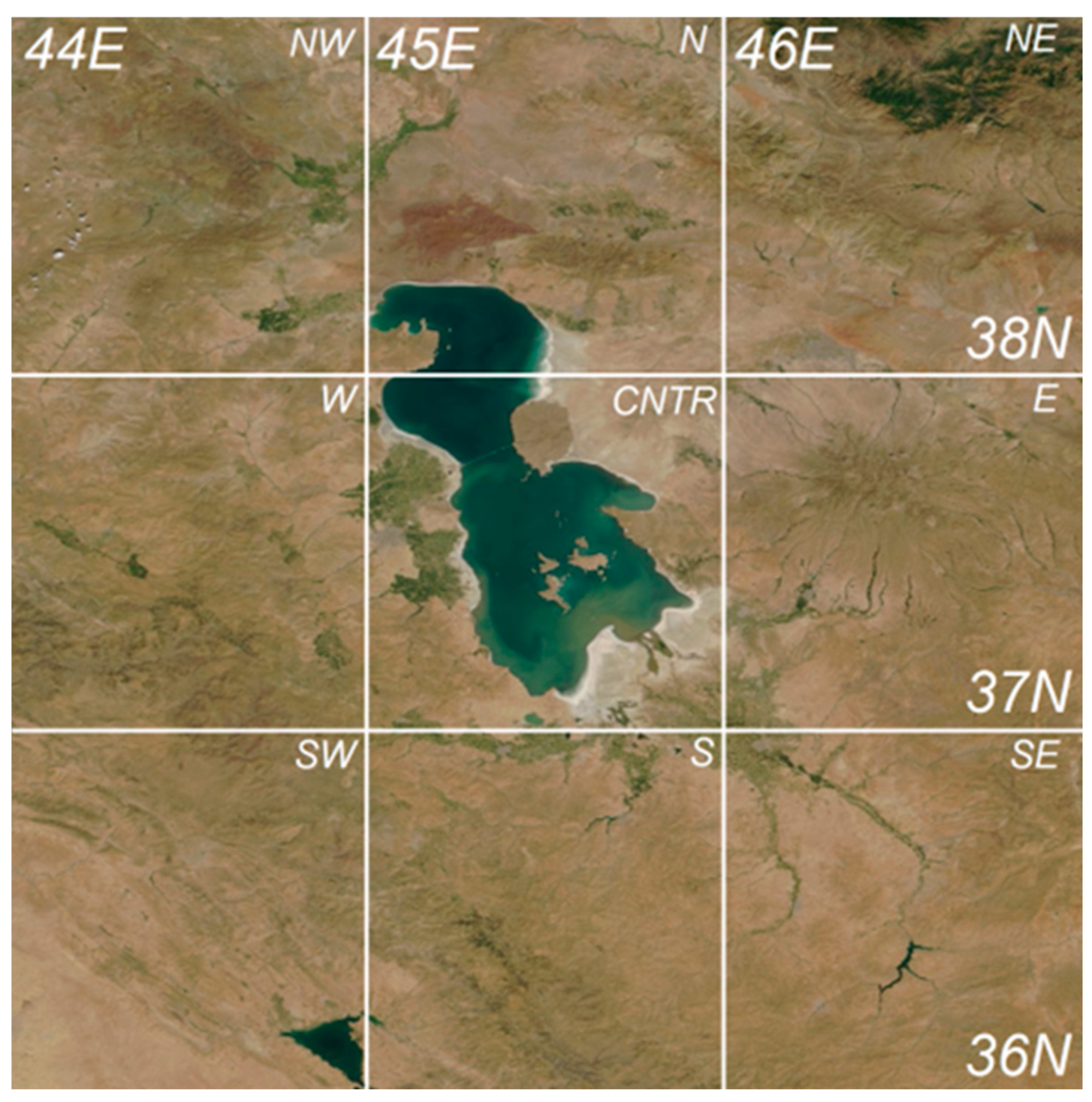
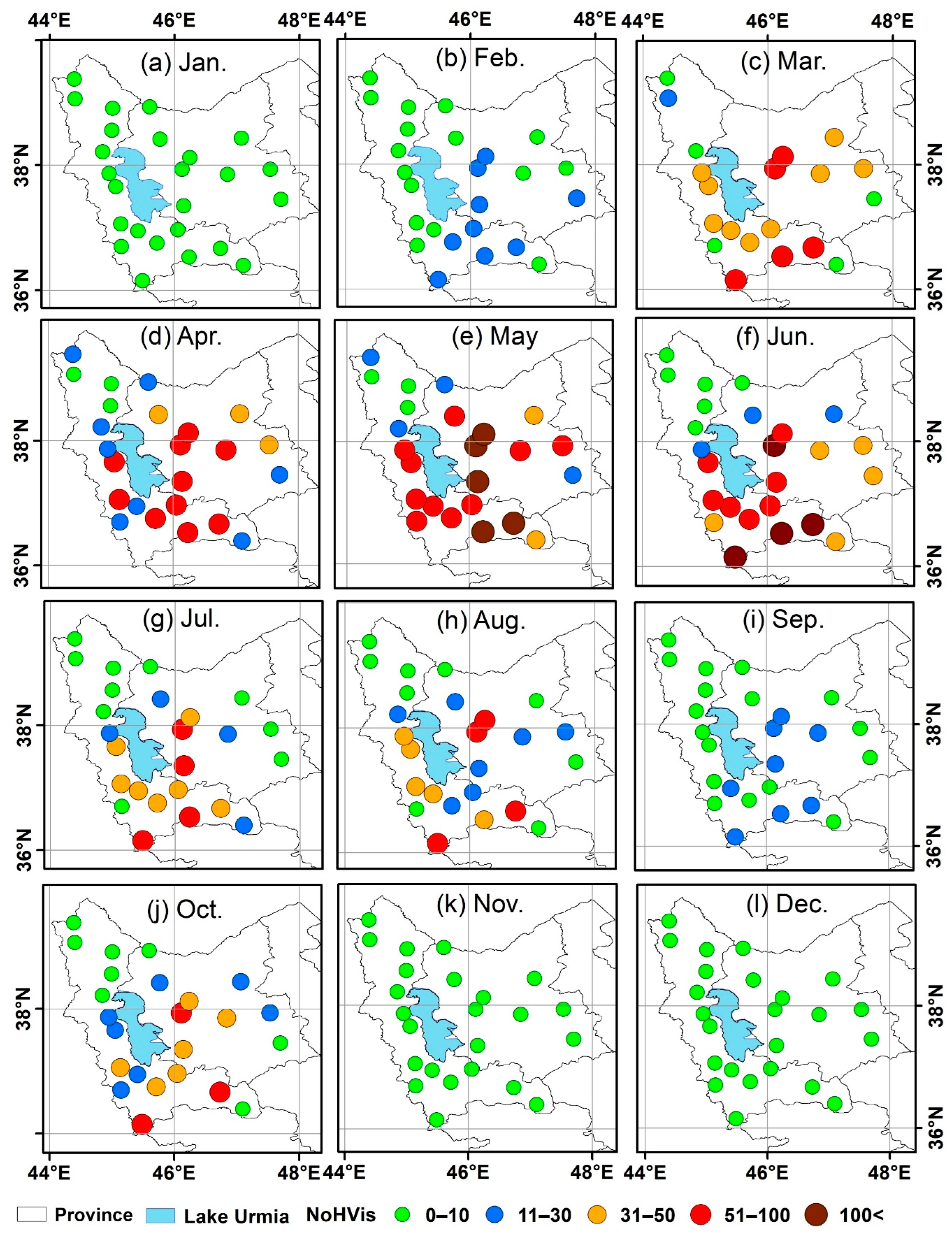
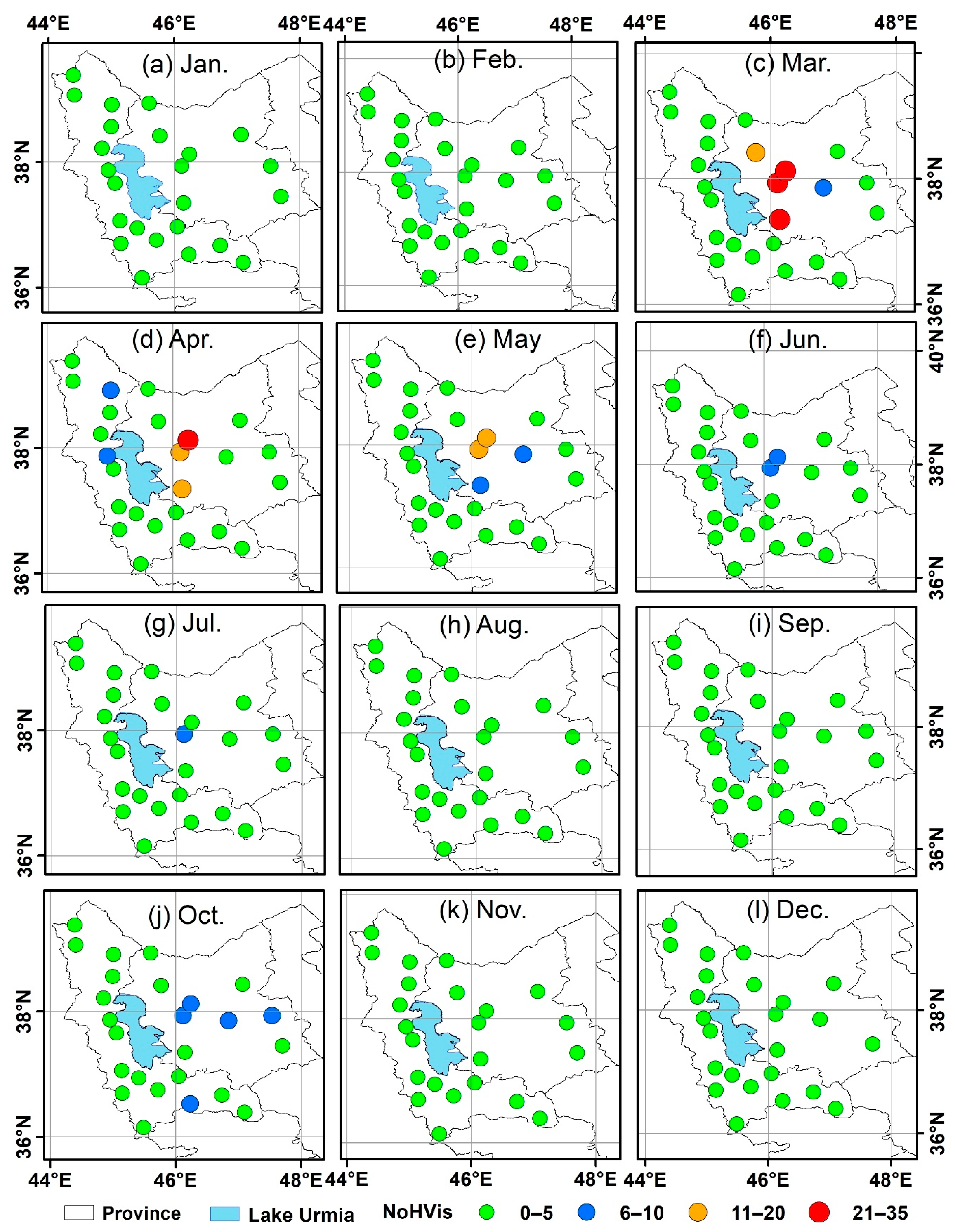
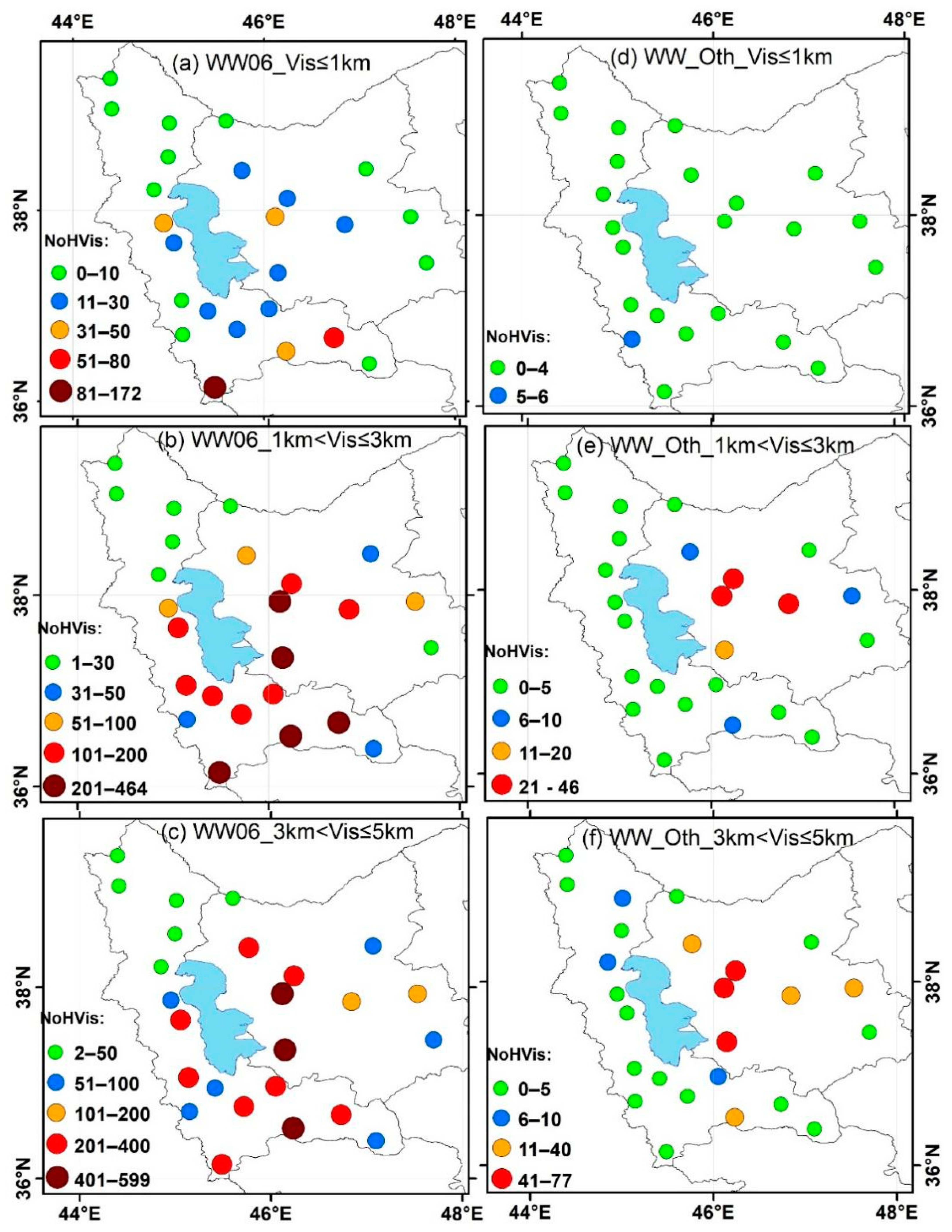
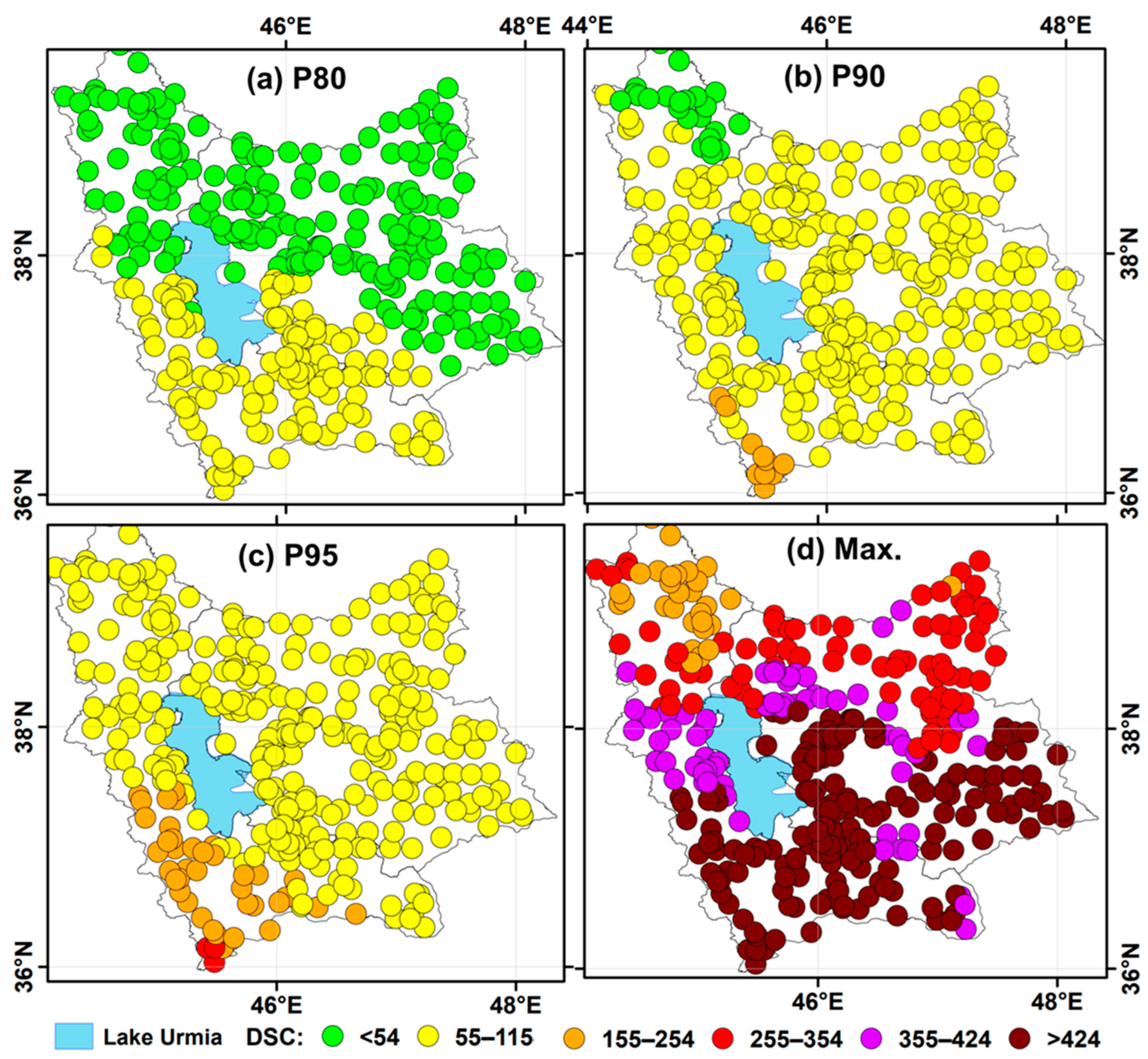
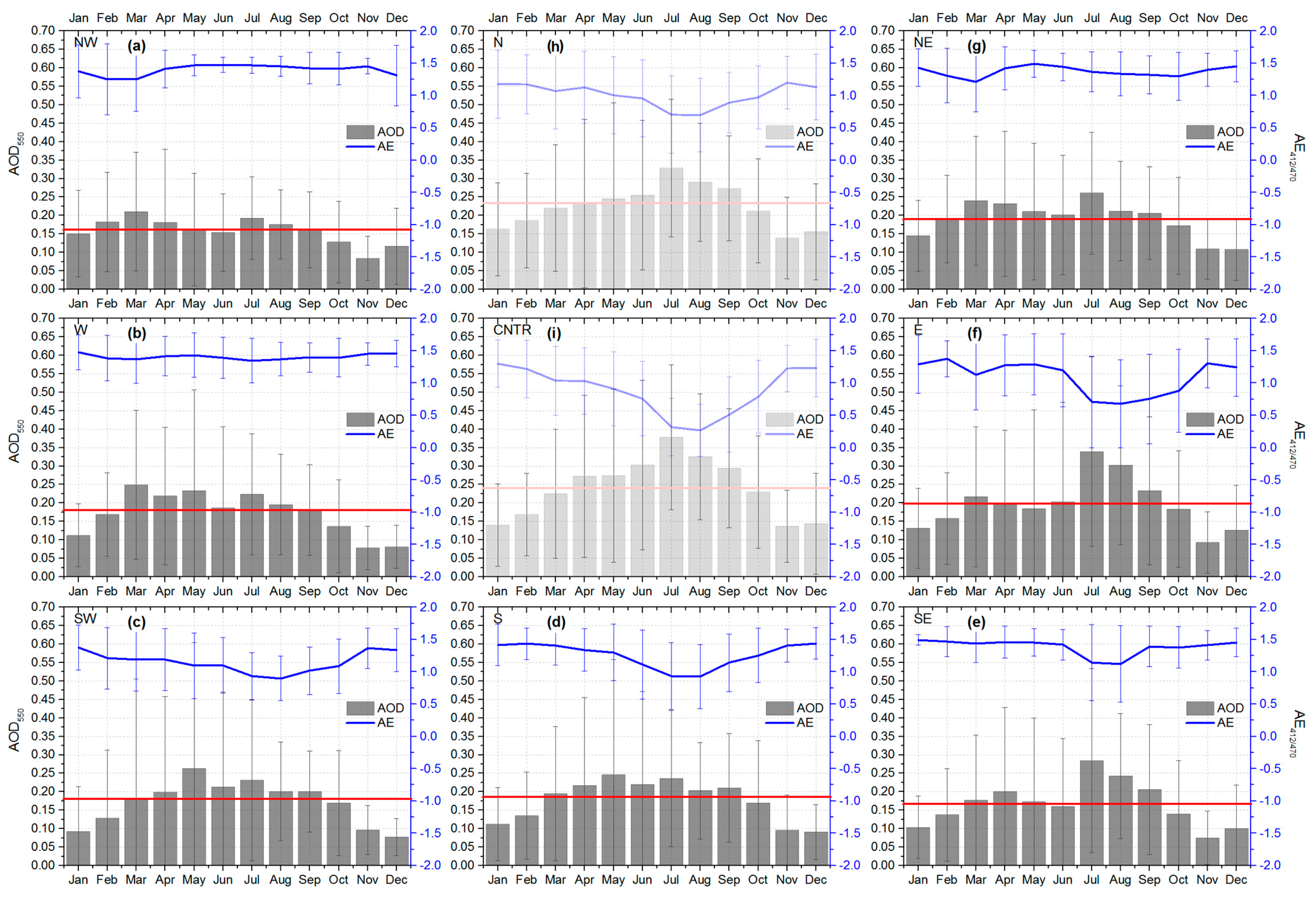
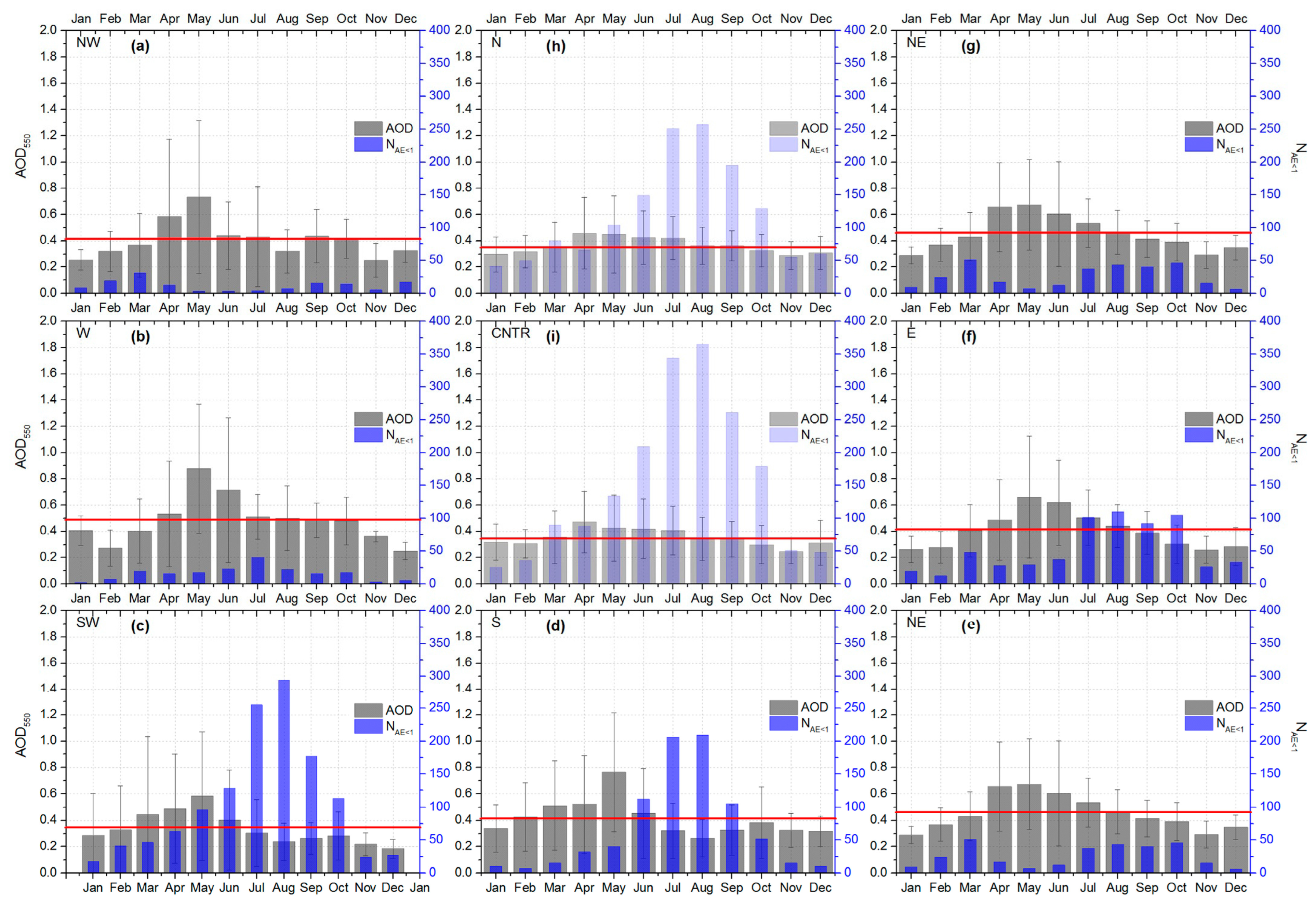

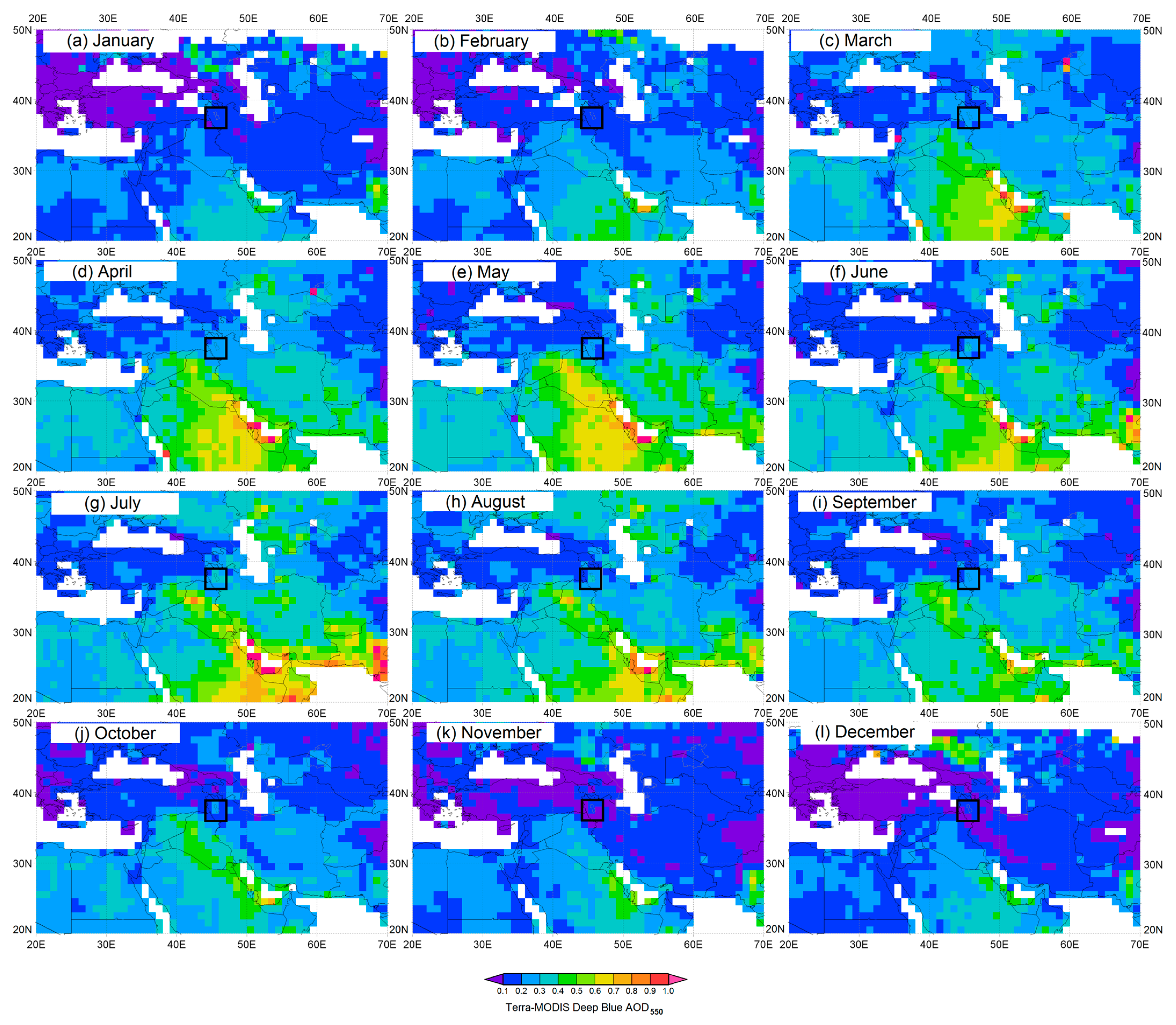
| Category | WW | Dust Code Definition |
|---|---|---|
| (i): Widespread Suspended Dust (WSD) | 06 | Widespread suspended dust that has not been raised by wind near or at the station, at the observation time. |
| (ii): Blowing Dust and Sand Storms (BDSS) | 07 | Sand or dust that has been raised by wind near or at the station at the observation time, but no well-developed SDS. |
| 08 | Sand or dust whirl(s) developed at or around the station, at the observation time or during the previous hour. | |
| 09 | Dust storm (DS) or sand storm (SS) that was sighted around the station or at the station during the previous hour. | |
| 30–32 | Slight or moderate DS or SS, visibility less than 1000 m but more than 200 m: 30: has decreased during the previous hour. 31: no considerable change during the previous hour. 32: has begun or has increased during the previous hour. | |
| 33–35 | Severe DS or SS, visibility less than 200 m: 33: has decreased during the previous hour. 34: no considerable change during the previous hour. 35: has begun or has increased during the previous hour. | |
| 98 | Thunderstorm combined with DS or SS at time of observation |
| Institution | Meteorological Driver | Meteorological Initial Fields | Emission Scheme | Horizontal Resolution | Vertical Resolution | Transport Size Bins | Data Assimilation |
|---|---|---|---|---|---|---|---|
| SEEVCCC | NMME | ECMWF/IFS | Uplifting [74] | 1/3° × 1/3° | 24 Eta-layers | 8 bins (0.1–10 µm) | Yes (ECMWF dust analysis) |
| Daily AQI Color |  |  |  |  |  |  |
|---|---|---|---|---|---|---|
| Level of Health Concern | Good | Moderate | Unhealthy for Sensitive Groups | Unhealthy | Very Unhealthy | Hazardous |
| PM10 (µg/m3) | 0–54 | 55–154 | 155–254 | 255–354 | 355–424 | >424 |
| AQI | 0–50 | 51–100 | 101–150 | 151–200 | 201–300 | >300 |
Disclaimer/Publisher’s Note: The statements, opinions and data contained in all publications are solely those of the individual author(s) and contributor(s) and not of MDPI and/or the editor(s). MDPI and/or the editor(s) disclaim responsibility for any injury to people or property resulting from any ideas, methods, instructions or products referred to in the content. |
© 2024 by the authors. Licensee MDPI, Basel, Switzerland. This article is an open access article distributed under the terms and conditions of the Creative Commons Attribution (CC BY) license (https://creativecommons.org/licenses/by/4.0/).
Share and Cite
Abadi, A.R.S.; Shukurov, K.A.; Hamzeh, N.H.; Kaskaoutis, D.G.; Opp, C.; Shukurova, L.M.; Ghasabi, Z. Dust Events over the Urmia Lake Basin, NW Iran, in 2009–2022 and Their Potential Sources. Remote Sens. 2024, 16, 2384. https://doi.org/10.3390/rs16132384
Abadi ARS, Shukurov KA, Hamzeh NH, Kaskaoutis DG, Opp C, Shukurova LM, Ghasabi Z. Dust Events over the Urmia Lake Basin, NW Iran, in 2009–2022 and Their Potential Sources. Remote Sensing. 2024; 16(13):2384. https://doi.org/10.3390/rs16132384
Chicago/Turabian StyleAbadi, Abbas Ranjbar Saadat, Karim Abdukhakimovich Shukurov, Nasim Hossein Hamzeh, Dimitris G. Kaskaoutis, Christian Opp, Lyudmila Mihailovna Shukurova, and Zahra Ghasabi. 2024. "Dust Events over the Urmia Lake Basin, NW Iran, in 2009–2022 and Their Potential Sources" Remote Sensing 16, no. 13: 2384. https://doi.org/10.3390/rs16132384
APA StyleAbadi, A. R. S., Shukurov, K. A., Hamzeh, N. H., Kaskaoutis, D. G., Opp, C., Shukurova, L. M., & Ghasabi, Z. (2024). Dust Events over the Urmia Lake Basin, NW Iran, in 2009–2022 and Their Potential Sources. Remote Sensing, 16(13), 2384. https://doi.org/10.3390/rs16132384










